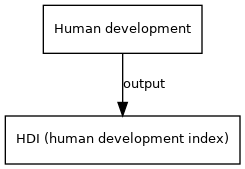HDI (human development index): Difference between revisions
Jump to navigation
Jump to search

m (Text replace - "|Status=Publishable" to "") |
m (Text replace - "VariableType=model |IsImpactIndicator=Yes" to "VariableType=model (end-indicator)") |
||
| Line 6: | Line 6: | ||
|Unit=none | |Unit=none | ||
|VariableType=model | |VariableType=model | ||
| | |VariableType=model (end-indicator) | ||
|Source2= | |Source2= | ||
|Reference= | |Reference= | ||
Revision as of 14:21, 27 January 2014
| Label: | Human Development Index (HDI) |
| Description: | The human development index (developed by UNDP) representing the development level of a country based on three components: income, education and longevity. |
| Dimensions: | time, region |
| Default unit: | none |
| Variable type: | model (end-indicator) |
Variable is output of model component:

- Click on a box to open the model component.
- from 2,2 documentation
The human development index (developed by UNDP) representing the development level of a country based on three components: income, education and longevity.
The HDI contains the following three dimensions:
- life expectancy at birth, representing a long and healthy life
- educational attainment, representing knowledge
- real gross domestic product (GDP in purchasing power parity, PPP dollars). This represents a decent standard of living.